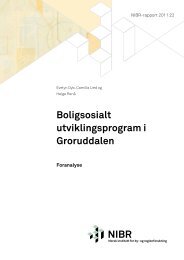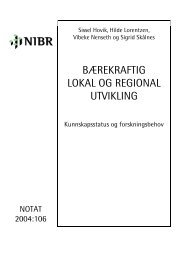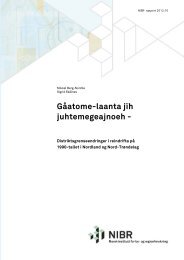http://www.tandfonline.com/page/terms-andconditions
The special importance of housing policy for ethnic minorities ...
The special importance of housing policy for ethnic minorities ...
- No tags were found...
Create successful ePaper yourself
Turn your PDF publications into a flip-book with our unique Google optimized e-Paper software.
4 H. Skifter Andersen et al.Downloaded by [Norsk Institutt for By og] at 07:07 11 March 2013housing. A hypothesis could be formulated that neighbourhoods with less attractive housingdominated by an easy to access tenure provide the basis for an initial influx of immigrants(Scaffer & Huang, 1975; Bleiklie, 1997; Søholt, 2007; Søholt & Astrup, 2009a).When the presence of ethnic groups be<strong>com</strong>es very visible, segregation processes called‘white flight’ and ‘white avoidance’ begin to appear. In the US it has been observed thatwhites ‘flee’ when the number of black residents in their neighbourhood exceeds a certainproportion of the population (Wright, Ellis, & Parks, 2005). A British study (Simpson &Finney, 2009) has shown that white flight is less important in the British case. In recentyears there has been a tendency to replace the concept of white flight with the more general‘white avoidance’, meaning that natives tend to avoid moving to neighbourhoods with manyimmigrants or special ethnic groups (Clark, 1992; Quillian, 2002; Bråmå, 2006; Bråmå &Andersson, 2010). As a consequence of these processes, it is easier for immigrants to gainaccess to these neighbourhoods, which are often dominated by certain tenures.As a result of the factors discussed above, and the segregation processes that follow,immigrants tend to reside in certain tenures and in less attractive or low-quality housing,often concentrated in certain neighbourhoods. The results are influenced by the structureof the housing market and the national and local housing policies that shape it.Methodology and research designAs stated in the introduction, we aim to <strong>com</strong>pare housing policies in four Nordic countriesin order to identify elements that have a special importance for the housing options andchoices of immigrants. This will be done by analysing the extent to which immigrants’housing position deviates from that of the whole population in the relevant country.One of the main reasons why immigrants’ housing situations diverge from those ofthe native population is that in general they have lower in<strong>com</strong>es. It is therefore of greatimportance for immigrants as to what extent there is sufficient affordable housing, withsatisfactory access possibilities to the different housing segments for low-in<strong>com</strong>e groups.If low-in<strong>com</strong>e households in general have good access to affordable and decent housing,immigrants will benefit greatly from this. We therefore have to examine to what extentthe housing position of immigrants on the housing markets can be explained by in<strong>com</strong>einequalities. If immigrants’ housing position can be fully explained by in<strong>com</strong>e inequalitiesand in<strong>com</strong>e differences between immigrants and the native population, there are no specialeffects of housing policies on immigrants.Housing inequalities between in<strong>com</strong>e groups, meaning to what extent housing opportunitiesfor different in<strong>com</strong>e groups are equal or unequal, will be measured by differencesin overcrowding between in<strong>com</strong>e groups in order to clarify whether there are high or lowdifferences in housing consumption between in<strong>com</strong>e groups, and by <strong>com</strong>paring ‘in<strong>com</strong>esegmentation’ in the housing market; that is, how different in<strong>com</strong>e groups are distributedon housing tenures. Segmentation of the housing market is a concept that has been usedto describe the way different people are allocated to different parts of the housing market(Lindberg & Lindèn,1989) or that different parts of the housing market are designed tomeet different kinds of demand (Rothenburg, Galster, Butler, & Pitkin, 1991).In<strong>com</strong>e segmentation is created when different tenures are, to a major extent, madeavailable and attractive for households in different in<strong>com</strong>e groups. Segmentation oftenmeans that high-in<strong>com</strong>e groups are concentrated in certain parts of the housing market,mainly owner-occupied detached housing, while low-in<strong>com</strong>e groups mostly reside in poorquality rental housing or social/public housing. Segmentation can result from the wayhousing subsidies are designed. Tax subsidies in owner-occupation are most favourable
















